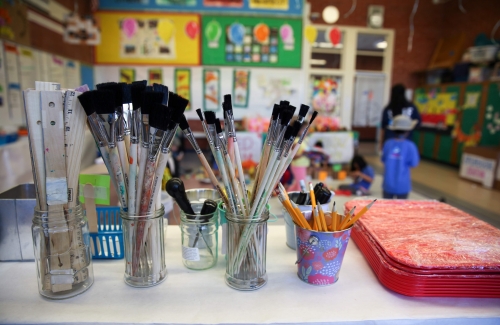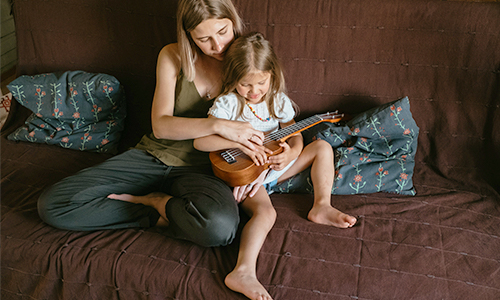Making the Summer to School Transition Easy and Fun This Fall

Have you ever had the experience of the characteristic fragrance of crayons filling the air as you open the familiar green and yellow box and scan the rows of varying shades, each holding the promise of creations yet unimagined? Is it also possible that this moment of reverie about years past are interrupted by your kids’ groans bringing you back to reality in the school supplies aisle, reminding you that not everyone has quite the same nostalgia about the impending transition?
When August arrives, change is in the air. Advertisements for “Back-to-School” sales bring a variety of reactions: excitement, dread, resignation. Assessing the mood and attitudes of your kids can inform the last few weeks of summer and determine how you approach the coming change. Summer camp may have come to a close, but by putting a positive spin on the summer to school transition this fall, parents can make it easy and fun for the whole family.
Giving the Transition a Positive Spin
Some kids are excited about back-to-school; they miss their friends or they revel in the challenge and routine of the school year. Then there are those who are none too happy about the end of summer vacation.
Whether they are experiencing apprehension or full-on dread of the return to school, some kids can struggle with a pessimistic attitude toward the coming transition and all that it represents. Those kids who need extra encouragement just might benefit from viewing this transition in a new light. To help ease the transition:
Connect the change to new rights and responsibilities.
Whether we like it or not, a new school year signals that kids are a year older, and hopefully, more mature. Now is the time to consider giving in to some of the requests kids have been making for additional privileges, like a later bedtime.
If last year’s school routine included an 8:00 pm bedtime, maybe it’s time to negotiate a half-hour reprieve. An 8:30 pm bedtime, when paired with sincere appreciation for how much they have grown and matured, will help kids feel that they are moving onward and up in the world.
Empower kids by offering some choice.
Do they want to buy their lunch a couple of days a week? Set up a school account and allow them to plan and keep track of their purchases. Would they enjoy picking some favorite foods to bring for lunch? Enlist kids’ help with choosing lunch ingredients and making a grocery list; they may just help with the chore of packing lunches, too.
Explore exciting extracurricular activities.
Perhaps you can get them excited about the start of the school year with the prospect of joining a club, sports team, or youth organization. Check out some confidence-building after-school resources here.
Use school shopping as a way to amp up the excitement.
School supplies and school clothes are typical purchases at this time of year. Letting kids pick out a few new things can start the season on a positive note. Even if their school clothes from last year still fit, allowing kids to choose a special pair of jeans or a cool new jacket could give them a touch of extra confidence. Check out the school dress code together, then let them go crazy—within reason.
Discuss and address kids’ apprehensions.
Emphasize a growth mindset, where practice and perseverance result in incremental progress toward skills acquisition. Review all the progress they have made to date and remind kids of goals they have achieved. Help them set realistic goals for this school year, then be there to cheer them on as they strive to achieve them.
Commit to continuing to spend time outdoors.
The advent of fall need not mean the end of outdoor fun. Ask kids to help you plan some activities to enjoy the coming season: a trip to a pumpkin patch, a fall colors tour, apple picking, or the cider mill.
Don’t let them see you sweat.
The back-to-school transition will be challenging for everyone; make a plan to ease into the fall schedule, especially if summer vacation has meant relaxed routines and later bedtimes. Rather than making a big change and experiencing culture shock the night before school starts, start inching toward your new routine the week before.
Celebrate and reflect on the summer as a family.
Start with a picnic or bonfire with s’mores, then give each family member the chance to talk about their favorite summer memories, new things they experienced, and what they learned. Discuss activities they would like to do again next year and new things they might like to try.
Easing Into the Mind Space
Hopefully, kids have had some fun, challenging, and rewarding experiences over the summer and have avoided the backslide that often occurs when school is in recess. In any case, as the start of school approaches, one of the best things you can do is read some books together to help kids ease into the mind space where literacy and reading comprehension rule.
For pre-readers, this may mean reading books to them and talking about the story. Help them make predictions, relate characters to people they know or propose an alternate ending.
If they can read (elementary right through high school), pick a novel and alternate reading every other page. Discuss plots twists and character traits, and have fun with it. You will both remember those last few days of summer vacation with warmth and longing once the frenzy of a new school year has set in.
Focus on the Positive
With the preponderance of mixed emotions associated with back-to-school time, it makes sense to help kids focus on the positive aspects this annual transition represents. Allowing them some appropriate privileges and choices at this key milestone will go a long way toward helping them to view it in a positive light. Try to preserve some of the best parts of summer as the seasons change, including family activities and time spent outdoors. And don’t forget to reflect on the summer and make some preliminary plans for next year.
Keep the fun coming all year long! The Innovator’s Club delivers the hands-on Galileo-style learning kids love on a weekly schedule with a convenient monthly subscription. In a consistent group led by an enthusiastic instructor, kids find something new to craft, construct or invent every week—igniting their curiosity and building lasting creative confidence along the way.

 Getting Kids to Talk (And Keep Talking) About Their School Day
Getting Kids to Talk (And Keep Talking) About Their School Day  School Supply Shopping Tips to Set Kids Up for Success
School Supply Shopping Tips to Set Kids Up for Success  Getting Kids to Try New Things: Strategies That Really Work
Getting Kids to Try New Things: Strategies That Really Work 